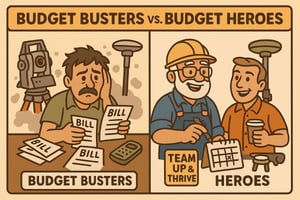Introduction Every now and then, I get one of those wild ideas that today’s the day I’m finally...
Mistakes Welcome: Why a Little Failure Builds a Smarter Team
Introduction: "The Day the Data Disappeared"
I once had a field tech who accidentally deleted half a day’s worth of data from the collector. It was a Friday, we were behind schedule, and the sun was doing that thing where it tries to fry your brain through your hard hat. My first instinct? Yell. Throw my hat. Maybe both.
But I didn’t. I asked him what happened. Turned out, it wasn’t laziness or carelessness. It was a training gap—and a simple one at that. We turned it into a teachable moment. Not just for him, but for the whole team. That day, we didn’t just fix a mistake—we built a culture shift.

Mistakes Happen—The Real Question Is, What Next?
If you're running a surveying crew or office team and expecting zero mistakes, you might as well expect GPS lock in a canyon. It’s not realistic.
Mistakes are part of the job, especially in high-pressure environments with moving parts, weather delays, complex instruments, and human beings. The question isn’t if someone will mess up. It’s what you do after they do.
You can punish, blame, and breathe fire—or you can turn it into fuel for growth.
Blame-Free Doesn’t Mean Accountability-Free
Let me be clear: this isn’t about giving people a free pass. It’s about teaching instead of torching. Accountability is still the name of the game—but real accountability means owning your role, understanding the impact of your decisions, and learning from each outcome, good or bad. If someone on the team makes a mistake, we don’t just shrug and move on. We take the time to review the misstep together, dissect exactly what went wrong, and use our project management software or internal checklists to pinpoint the root cause. If the process failed, we update it. If training was the gap, we fix it. The conversation is candid, but never punitive.
But we don’t shame people. We don’t turn one error into a team-wide freeze or a culture of fear. Nobody gets singled out or made to feel like the worksite scapegoat. Instead, we reinforce that errors are a signal, not a verdict—an opportunity to sharpen our systems and skill sets rather than put someone in the hot seat. By replacing blame with honest feedback and actionable improvements, we foster a culture where people stay engaged, keep growing, and actually look out for each other on the job.
That’s the difference between a crew that grows stronger and one that walks on eggshells. When people know the standard is high but the support is real, they step up. They ask questions, flag potential issues earlier, and take responsibility for their own development. And that, in our industry and within Kudurru Stone, is exactly how you build a team that’s both resilient and reliable—one that learns from mistakes and turns every setback into a springboard for greater success.
Building a Culture of Safety—Psychological Safety
In our crew, psychological safety means knowing you can speak up, ask questions, and even say, “I messed up,” without fear of being thrown under the truck. People need to trust that their concerns, errors, or gaps in understanding will be met with support, not mockery or blame. If someone flags a problem or doesn’t know how to use a new piece of survey equipment, that transparency is valued, not penalized. We operate in an industry where the smallest miscommunication can ripple out into lost time, rework, or compliance headaches. That’s why candor and vulnerability are assets, not liabilities.
When someone asks me something basic—how to label a plat file or why we stake a certain way—I don’t roll my eyes. I’m grateful. Because every question asked is a mistake prevented. By building a space where curiosity is encouraged, we close knowledge gaps before they become operational risks. Whether it’s a green apprentice or a seasoned project manager, the expectation is the same: if you see something unclear, speak up—because every one of us is working toward the same goal of quality results and client satisfaction.
This kind of culture doesn’t happen by accident. You build it by modeling calm when mistakes happen, by praising ownership, and by reminding folks that learning isn’t linear. When an error does occur, we focus on understanding and correcting, not punishing. Leaders set the tone—addressing setbacks calmly, highlighting what was learned, and appreciating individuals who admit what they don’t know. Over time, this approach transforms the team from risk-averse and silent to proactive, confident, and highly collaborative. That’s how you create a crew that does more than follow orders—they think critically, take responsibility, and help raise the standard for everyone around them.
How We Turn Mistakes Into Learning Moments
We’ve made a habit of doing short debriefs after issues come up. Doesn’t matter if it was in the field or behind a desk.
Example: A miscommunication between our admin and PMs caused duplicate billing. Instead of a scolding, we pulled the team together, figured out where the process broke down, and made a checklist to prevent it going forward.
Now, everyone feels safer bringing up confusion early—and our workflows are tighter than ever.
Conclusion: Mistakes Are Teachers
The smartest, most capable folks on my team? They’re the ones who’ve screwed up—and learned.
If you want a team that thinks on its feet, adapts under pressure, and grows over time, you’ve got to let them make a few missteps along the way. And you’ve got to be the kind of leader who sees those missteps as opportunities, not just headaches.
So the next time someone on your team makes a mistake, ask: What do we learn? What do we fix? And how do we support them as they get better?
Because a team that learns from mistakes is a team that gets better every single day. And that’s the kind of crew worth building.




